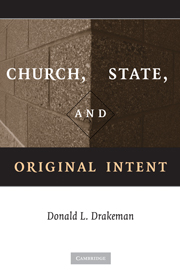Book contents
- Frontmatter
- Contents
- Preface
- 1 Introduction
- 2 Reynolds: The Historical Construction of Constitutional Reality
- 3 Everson: A Case of Premeditated Law Office History
- 4 The Battle for the Historical High Ground
- 5 Original Meanings: Where Is the Historical High Ground?
- 6 Incorporating Originalism
- 7 Conclusion
- Bibliography
- Index
6 - Incorporating Originalism
Published online by Cambridge University Press: 05 June 2012
- Frontmatter
- Contents
- Preface
- 1 Introduction
- 2 Reynolds: The Historical Construction of Constitutional Reality
- 3 Everson: A Case of Premeditated Law Office History
- 4 The Battle for the Historical High Ground
- 5 Original Meanings: Where Is the Historical High Ground?
- 6 Incorporating Originalism
- 7 Conclusion
- Bibliography
- Index
Summary
Introduction
“Enigmatic” may not be a strong enough word to describe the federal government's relationship to religion in the four score years separating the First and Fourteenth Amendments. Yet if we want to reflect on what the establishment clause may have meant when it was adopted – or how its meaning may have been worked out over time – it seems to make sense to look at what various interpreters from 1789 through the Civil War and Reconstruction thought it meant. That is, if one of our originalist questions is framed along the lines of: Assuming that the Fourteenth Amendment made the establishment clause applicable to state governments, what did that clause mean when the Fourteenth Amendment was adopted? then we would be well served to consider what issues may have tested the limits of Congress's interactions with religion up to that time. There were certainly heated church-state disputes taking place at state and local levels, but the best evidence of what the establishment clause meant in 1868 is (probably) the history of how it was interpreted and applied to federal issues prior to that time.
Viewed from the twenty-first century, after nearly a full century of an energetic commitment by the Supreme Court to reviewing and frequently striking down a wide range of federal and state laws touching religion, it seems surprising, perhaps shocking, to see how little interpretive guidance we can obtain from the Supreme Court.
- Type
- Chapter
- Information
- Church, State, and Original Intent , pp. 263 - 325Publisher: Cambridge University PressPrint publication year: 2009



